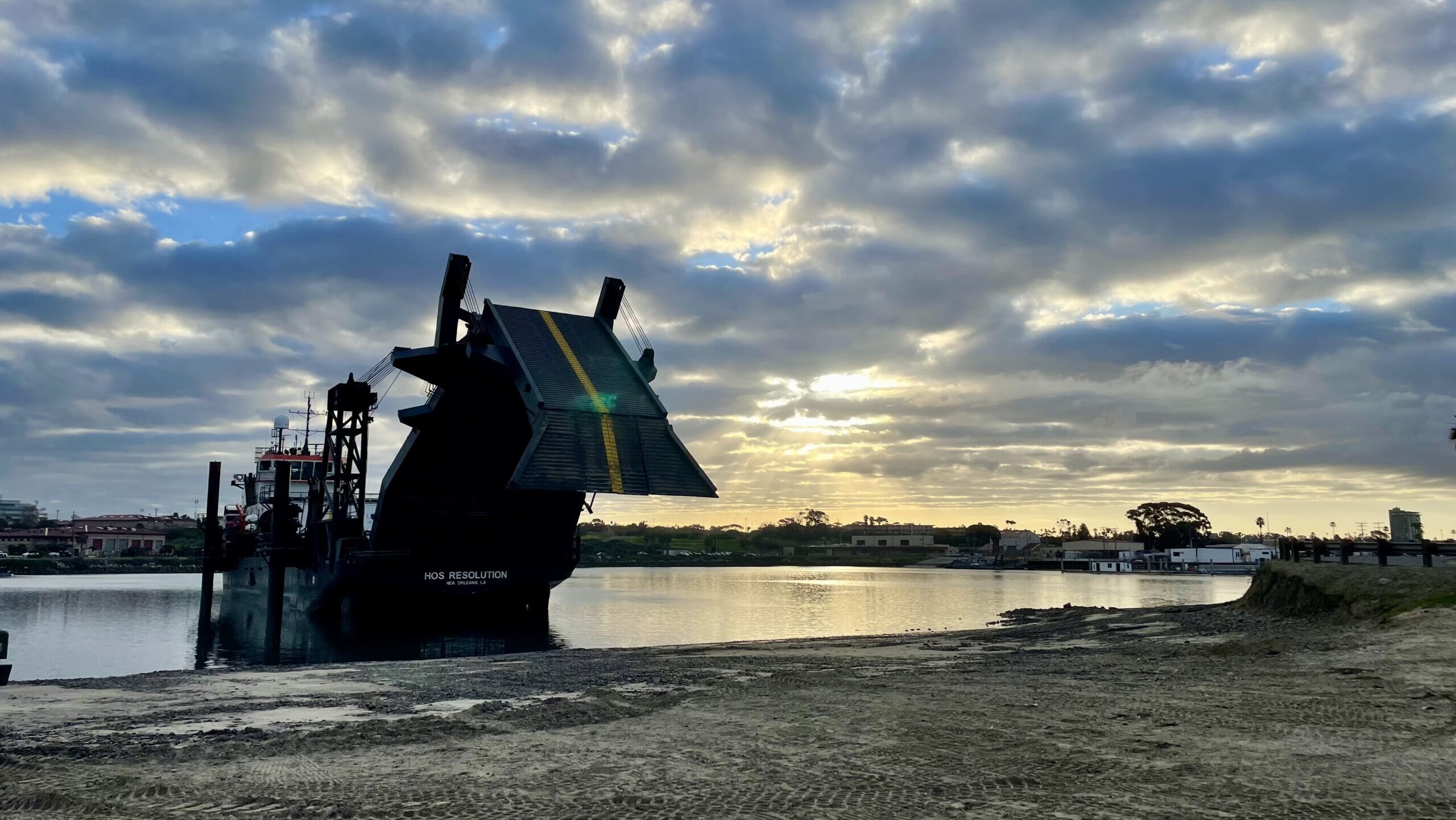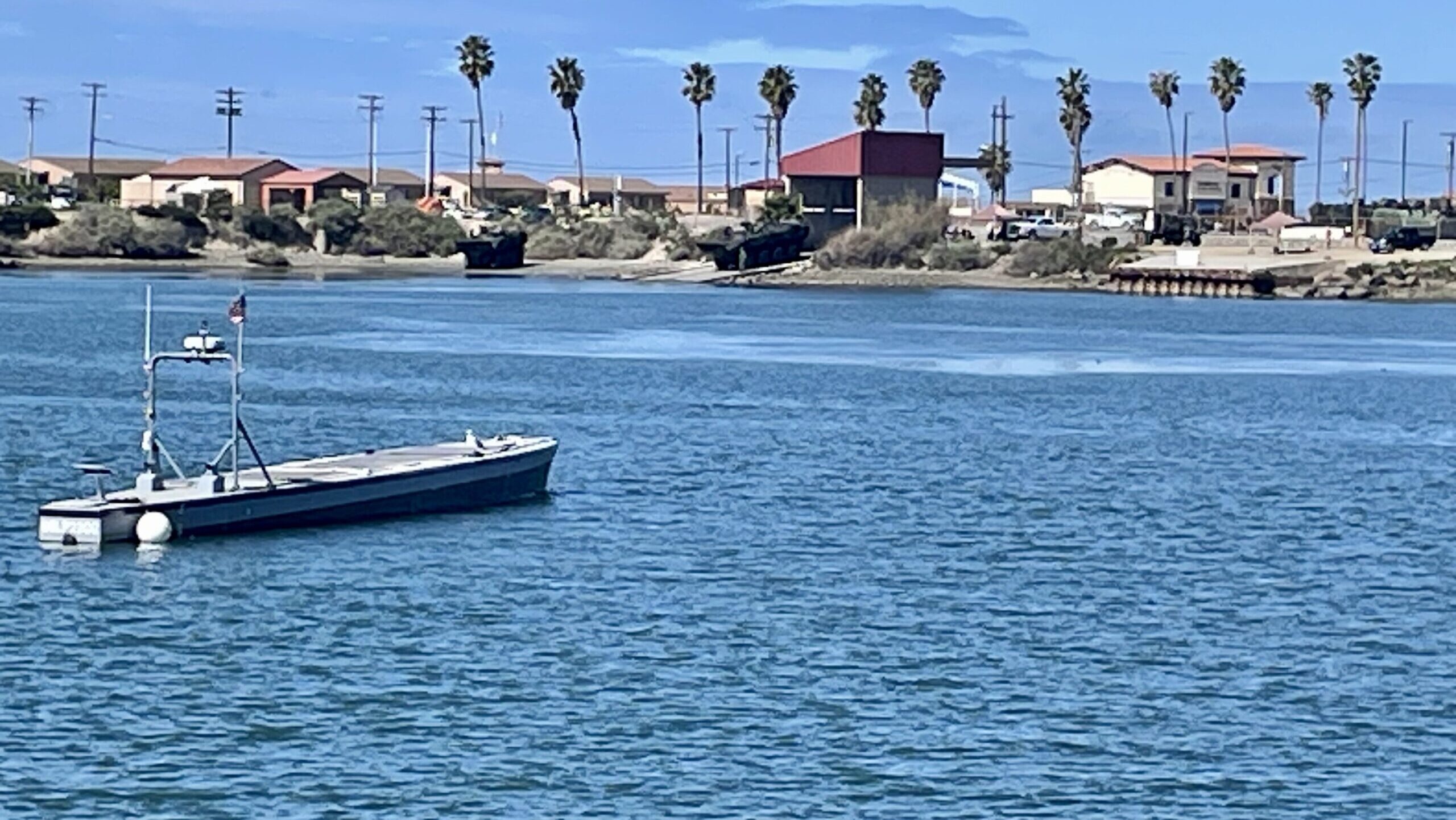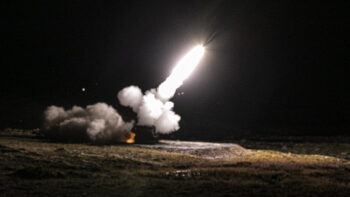
During sunrise on March 1 at Camp Pendleton, the USMC lowered the ramp of its first stern landing vessel prototype. (Ashley Roque/ Breaking Defense)
CAMP PENDLETON, Calif. — Mechanical issues sidelined a US Army small, prototype logistics watercraft from participating in this year’s Project Convergence Capstone 4 event, but two Marine Corps vessels were on hand. And even though the ships in question weren’t wearing Army green, that doesn’t mean America’s largest military service can’t take advantage to work out future requirements and operating concepts.
During this year’s Army capstone event, the service used its stint in Southern California, in part, to examine ways to better prepare for joint force logistic needs in a region consisting of islands and water.
“In a larger-scale combat operation like [the] Indo-Pacific, we’ll have [watercraft to] first project equipment and troops into island chains, for example, but also resupply. That joint resupply could be a Navy vessel, Army vessel, Marine Corps vessel,” Army Col. Shane Upton, the director of the Contested Logistics Cross Functional Team, told Breaking Defense during a Feb. 28 interview.
While it had been planning to test out its first Maneuver Support Vessel-Light (MDV-L) prototype, a vessel produced by Vigor Works and accepted by the Army on Feb. 5, all did not go as planned. While it was enroute to Camp Pendleton, the MSV-L “experienced mechanical issues” and returned to a location near the company for “evaluation,” according to Zina Kozak-Zachary, the project manager for transportation systems within the Program Executive Office Combat Support & Combat Service Support.
“The product office is assessing repair options with the [original equipment manufacturer] OEM and working to execute the corrective action as quickly as possible,” she wrote in a March 1 email. “It is not uncommon for first-of-class watercraft prototypes such as the MSV-L to experience mechanical issues at this point in the lifecycle.”
Once repairs are completed, Kozak-Zachary said the service will resume testing designed to help guide decisions about future vessel requirements.
Marines Taking To Water
Although the Army didn’t have its new logistics prototype vessel at this year’s event, the USMC was there with two logistics watercraft designs its eyeing for littoral operations in the Indo-Pacific — Resolution, a stern landing vessel (SLV) that is a prototype for a future Landing Ship Medium (LSM), and one of the concept designs for a Autonomous Low-Profile Vessel.
The Marine Corps currently has a one-year lease on the 254-foot Resolution SVL with two additional versions in the pipeline. While LSM requirements have been firmed up, the service is using events like Project Convergence to work through the tactics, techniques and procedures of how they want to use the future fleet.

One of the USMC’s Autonomous Low-Profile Vessel concept designs was at the Project Convergence capstone event this year. (Ashley Roque/Breaking Defense)
“We don’t have to wait until we get the LSM [in the late 20s or early 30s] to do that work: we’re kind of front loading how we would employ them without having the actual LSMs,” Lt. Col. Timothy Smith, the Marine Corps Warfighting Lab’s logistics combat element lead, told Breaking Defense during a March 1 interview.
For Project Convergence that meant, in part, using Resolution for combined joint logistics over-the-shore exercises, to include loading and off-loading vehicles and other equipment and exploring how to command and control that vessel, explained Maj. Dan Greenlee, a maritime sustainment planner with the Marine Corps Warfighting Lab.
“Because we don’t own the ship, what we were really first learning is just the challenges when it comes to communications, communications architecture,” Greenlee added. “How do we control and understand situational awareness? Where the vessel is at any given time? How are we going to catch it? And then, what does it take to accomplish the communications when it comes to [that] commercially owned vessel.”
Over the course of a couple of weeks, USMC officials also explored ways to pair the leased landing craft with new autonomous tech, including the TRV-150 Tactical Resupply Unmanned Aircraft System that can ferry up to 150-pounds of supplies from ship-to-ship or ship-to-shore.
One of the USMC’s Autonomous Low-Profile Vessels (ALPVs) was also in the Southern California water and was used to offload supplies from Resolution and ferry the trove to either shore or another vessel.
“When you see those two things together [ALPV and Resolution], that’s a very powerful moment for a Marine Littoral Regiment…that gives us the ability to move classes of supply” around that the service doesn’t have today, said Col. Peter Eltringham, the commander of the new 12th Marine Littoral Regiment.
“That [ALPV] is a phenomenal piece of gear: We can put that to immediate use,” he later added. But he’s unlikely to receive one quickly: Marine Corps leaders have not yet approved the requirements for such an autonomous water vessel, and it is up to Eltringham and others to help define and demonstrate just what logistics capabilities Marine Littoral Regiments need to sustain themselves.
The Marines’ will likely not be alone in an endeavor to field such an autonomous vessel. Army officials like Upton, the colonel heading up the new contested logistics cross-functional team, are eagerly watching what the sister service does, and those observations could drive a set of similar requirements inside the Army.
“When you talk watercraft…if you go to a beach, you’re probably going to be targeted, if you could leave some loitering offshore and start resupplying [with] smaller faster watercraft, not the huge ships like you see deploy out of ports… it becomes, quite frankly, a calculation by the enemy of what do you target?” he said.






















